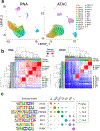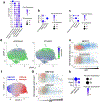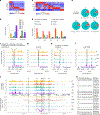A single-nuclei paired multiomic analysis of the human midbrain reveals age- and Parkinson's disease-associated glial changes
- PMID: 38491288
- PMCID: PMC11361719
- DOI: 10.1038/s43587-024-00583-6
A single-nuclei paired multiomic analysis of the human midbrain reveals age- and Parkinson's disease-associated glial changes
Abstract
Age is the primary risk factor for Parkinson's disease (PD), but how aging changes the expression and regulatory landscape of the brain remains unclear. Here we present a single-nuclei multiomic study profiling shared gene expression and chromatin accessibility of young, aged and PD postmortem midbrain samples. Combined multiomic analysis along a pseudopathogenesis trajectory reveals that all glial cell types are affected by age, but microglia and oligodendrocytes are further altered in PD. We present evidence for a disease-associated oligodendrocyte subtype and identify genes lost over the aging and disease process, including CARNS1, that may predispose healthy cells to develop a disease-associated phenotype. Surprisingly, we found that chromatin accessibility changed little over aging or PD within the same cell types. Peak-gene association patterns, however, are substantially altered during aging and PD, identifying cell-type-specific chromosomal loci that contain PD-associated single-nucleotide polymorphisms. Our study suggests a previously undescribed role for oligodendrocytes in aging and PD.
© 2024. The Author(s), under exclusive licence to Springer Nature America, Inc.
Conflict of interest statement
Competing interests
Y.T. works as a consultant in Colossal Biosciences. The other authors declare no competing interests.
Figures













References
-
- Parkinsonʼs Foundation. Statistics. https://www.parkinson.org/understanding-parkinsons/statistics
-
- Pringsheim T, Jette N, Frolkis A & Steeves TD The prevalence of Parkinson’s disease: a systematic review and meta-analysis. Mov. Disord 29, 1583–1590 (2014). - PubMed
-
- Dauer W & Przedborski S Parkinson’s disease: mechanisms and models. Neuron 39, 889–909 (2003). - PubMed
-
- Hindle JV Ageing, neurodegeneration and Parkinson’s disease. Age Ageing 39, 156–161 (2010). - PubMed
MeSH terms
Substances
Grants and funding
- R01 NS100919/NS/NINDS NIH HHS/United States
- R01 NS101461/NS/NINDS NIH HHS/United States
- NS101461/U.S. Department of Health & Human Services | NIH | National Institute of Neurological Disorders and Stroke (NINDS)
- NS100919/U.S. Department of Health & Human Services | NIH | National Institute of Neurological Disorders and Stroke (NINDS)
LinkOut - more resources
Full Text Sources
Medical
Molecular Biology Databases

